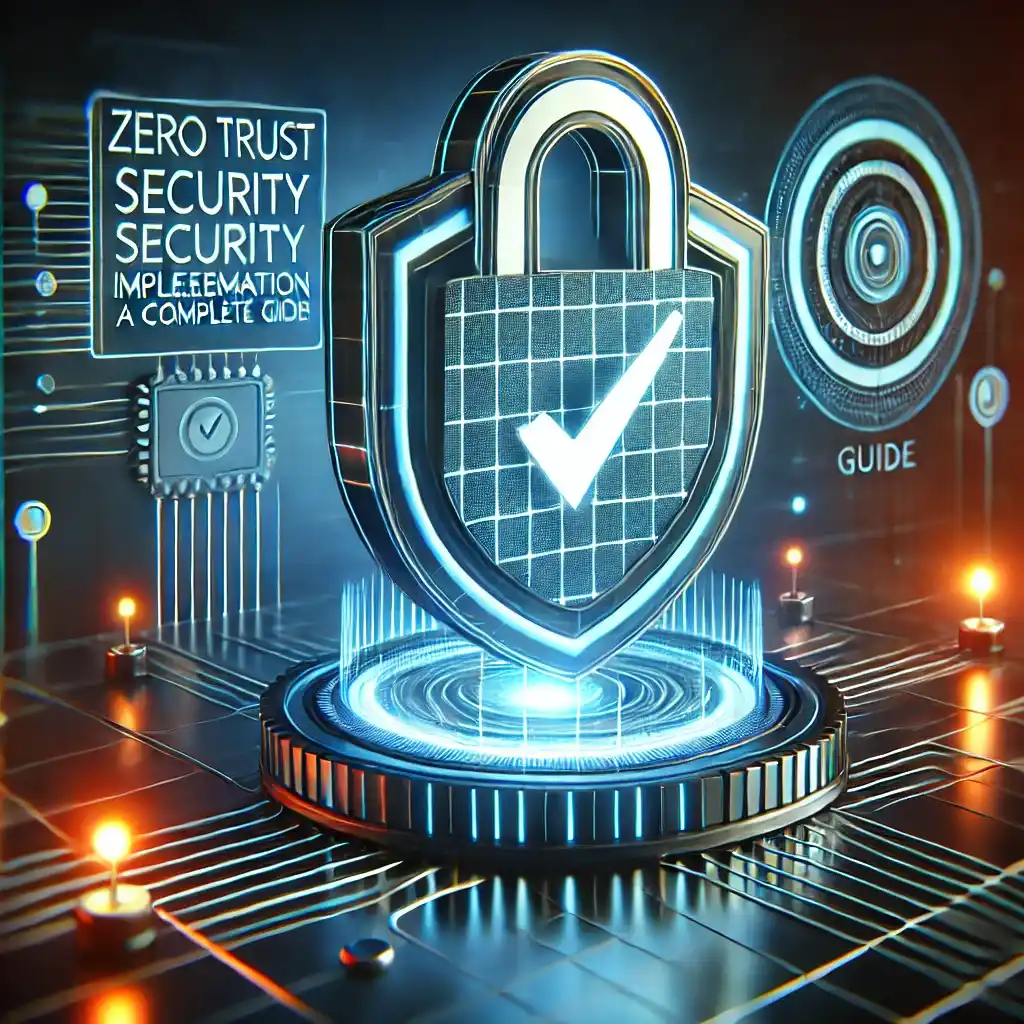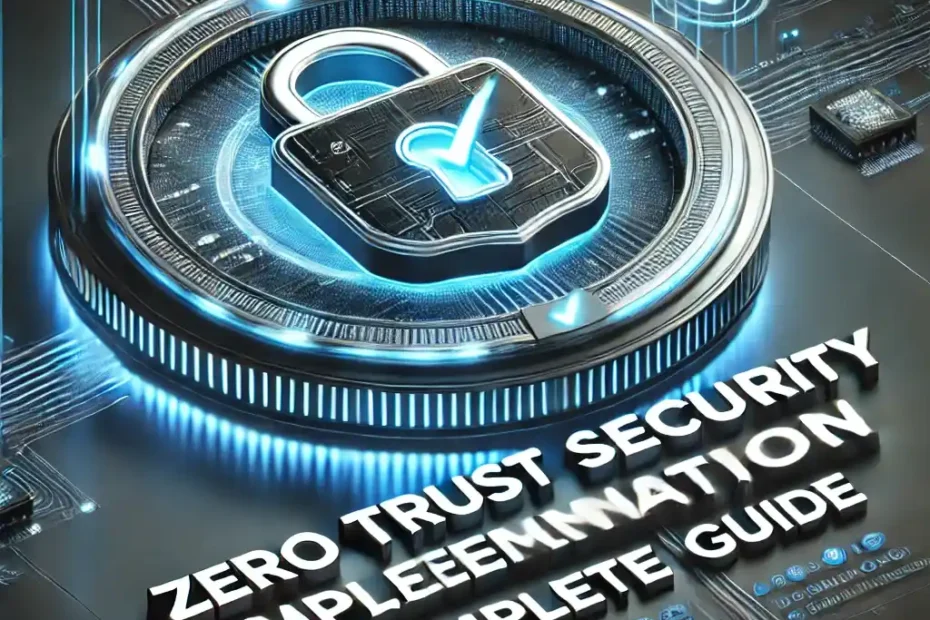1. Introduction to Zero Trust Security
What is Zero Trust Security?
In the past, companies relied on the perimeter security model, where networks were protected with firewalls and VPNs. However, this approach is outdated because cyber threats are now more advanced. Zero Trust Security ensures that no user or device is automatically trusted. Every access request must be verified, whether it comes from inside or outside the organization.
This model is especially important in today’s world, where remote work, cloud computing, and third-party integrations have expanded attack surfaces. Zero Trust Security Implementation requires organizations to move beyond traditional security models and adopt a Zero Trust Strategy that enforces strict access control, identity verification, and continuous monitoring.
Understanding the Zero Trust Model and Framework
The Zero Trust Model follows a strict “never trust, always verify” policy. Unlike traditional security, which assumes users within the network are safe, Zero-Trust Security operates under the assumption that every user and device could be a potential threat.
The Zero Trust Framework ensures that security measures are applied at all levels of an organization’s IT infrastructure, including:
- Users and identities – Ensuring strong authentication and access controls.
- Applications and data – Protecting sensitive information with encryption and segmentation.
- Networks and endpoints – Securing access to cloud and on-premises resources.
Key Zero Trust Principles
- Continuous Verification – Always authenticate and validate access requests before granting permissions.
- Least Privilege Access – Give users only the necessary permissions they need to perform their jobs.
- Assume Breach – Always be prepared for a security attack by implementing strict monitoring and quick response measures.
With cyberattacks becoming more frequent and sophisticated, organizations that fail to implement Zero Trust Security leave themselves vulnerable to data breaches, ransomware, and insider threats.

2. Zero Trust Security Architecture and Strategy
What is Zero Trust Architecture (ZTA)?
Zero Trust Architecture (ZTA) is the technical foundation of Zero Trust Security Implementation. It includes the tools, technologies, and processes required to implement Zero Trust Security across an entire organization.
A key component of ZTA is Zero Trust Network Access (ZTNA), which replaces traditional VPNs by offering secure, identity-based access to applications and data. Unlike VPNs, which grant broad network access, ZTNA ensures that users only access specific resources based on strict identity verification.
Building a Zero Trust Security Strategy
To successfully implement Zero Trust Security, organizations need a clear roadmap and strategy. The key steps include:
- Defining a Zero Trust Policy – Establish security rules and access control measures.
- Zero Trust Governance – Set up a framework for managing security policies.
- Zero Trust Security Controls – Implement mechanisms like Multi-Factor Authentication (MFA), Least Privilege Access, and Microsegmentation.
- Zero Trust Security Compliance – Align security practices with GDPR, HIPAA, and NIST Zero Trust Architecture.
Organizations that follow these steps can reduce their attack surface, improve visibility into security risks, and prevent unauthorized access.
3. Key Components of Zero Trust Security
Identity and Access Management (IAM)
IAM is at the heart of Zero Trust Security Implementation. It ensures that every user, device, and application is authenticated and authorized before accessing resources.
- Zero Trust Identity Management uses strong authentication mechanisms such as biometrics, passwordless logins, and Single Sign-On (SSO).
- Zero Trust Authentication enforces Multi-Factor Authentication (MFA), requiring users to verify their identity through multiple steps.
- Zero Trust Authorization ensures that users can only access specific resources based on their role and permissions.
Microsegmentation and Endpoint Security
- Zero Trust Microsegmentation breaks networks into small, secure zones to limit lateral movement in case of a breach.
- Zero Trust Endpoint Security ensures that devices accessing the network comply with security policies.
Data and Cloud Security
- Zero Trust Data Protection ensures that sensitive data is encrypted, monitored, and accessed only by authorized users.
- Zero Trust Cloud Security applies Zero Trust principles to cloud applications, ensuring secure remote access.

4. Steps to Implement Zero Trust Security
Step 1: Zero Trust Assessment
The first step in Zero Trust Security Implementation is conducting a Zero Trust Assessment to identify security gaps, risks, and weaknesses. Organizations should analyze network traffic, access control mechanisms, authentication methods, and user behavior to detect vulnerabilities. This assessment helps define what needs protection, who needs access, and which security policies should be enforced.
Step 2: Define a Zero Trust Policy
A Zero Trust Policy is the foundation of a successful Zero Trust Security Strategy. This policy should outline:
- Who is allowed to access specific resources?
- What level of authentication is required?
- How is access continuously monitored?
Organizations should implement Zero Trust Access Control (ZTAC), ensuring that users and devices get access based on their identity, role, and security posture.
Step 3: Deploy Zero Trust Security Solutions
Companies should deploy Zero Trust Security Solutions such as Zero Trust Network Access (ZTNA), Identity and Access Management (IAM), Multi-Factor Authentication (MFA), and AI-driven security analytics. These tools work together to authenticate users, monitor network traffic, and detect threats in real-time.
Step 4: Implement Zero Trust Cloud Security
With cloud adoption growing, Zero Trust Cloud Security ensures that cloud-based applications and remote access points follow strict authentication and least privilege access principles. Using Zero Trust for SaaS platforms, multi-cloud environments, and remote workers ensures data security across all access points.
Step 5: Enable Zero Trust Threat Detection
Threat detection is crucial in a Zero Trust framework. AI-powered Zero Trust Analytics and behavioral analysis can help detect suspicious activities like unauthorized logins, unusual file transfers, or access requests from unknown locations.
Step 6: Zero Trust Security Automation
To improve security efficiency, organizations should leverage Zero Trust Security Automation. Automated tools can block threats instantly, revoke access when anomalies are detected, and enforce compliance policies without human intervention.
5. Technologies Powering Zero Trust Security
Zero Trust VPN Alternative
Traditional VPNs have been the standard for remote access, but they come with risks such as broad network exposure, lack of granular access control, and vulnerability to phishing attacks. Zero Trust Network Access (ZTNA) provides a more secure alternative by granting role-based access to applications without exposing the entire network.
Key advantages of ZTNA over VPNs include:
- Granular access control – Users can only access authorized apps and data.
- Reduced attack surface – Hackers cannot scan or move laterally across networks.
- Stronger authentication – Every access request is verified before being approved.
Role of AI and Zero Trust Analytics
Artificial intelligence (AI) is a game-changer for Zero Trust Security. AI-powered Zero Trust Analytics help security teams detect and respond to threats faster by analyzing massive amounts of data in real time.
Key benefits of AI-driven Zero Trust Monitoring include:
- Anomaly detection – AI can recognize unusual behaviors such as multiple failed login attempts or access from unfamiliar locations.
- Real-time security alerts – AI-powered systems can notify administrators of potential threats before they escalate.
- Automated security enforcement – AI can block access, quarantine threats, and enforce Zero Trust policies without human intervention.
By combining AI, ZTNA, and continuous monitoring, organizations can create a proactive, self-adaptive security system that strengthens Zero Trust Security Implementation.
6. Benefits of Zero Trust Security

1 Reduces Cybersecurity Risks
A well-implemented Zero Trust Security Strategy significantly reduces cybersecurity risks by ensuring that every access request is authenticated, authorized, and continuously verified. By eliminating implicit trust, organizations can prevent data breaches, insider threats, and advanced persistent threats (APTs).
2 Enhances Security, Compliance, and Risk Management
One of the biggest Zero Trust Security Benefits is its ability to help organizations meet regulatory compliance requirements such as GDPR, HIPAA, and NIST Zero Trust guidelines. By enforcing Zero Trust Compliance, companies can avoid fines, lawsuits, and reputational damage caused by data breaches.
3 Prevents Insider Threats
A major challenge in cybersecurity is insider threats, where employees, contractors, or third parties misuse their access privileges. Zero Trust Insider Threat Protection ensures that no user gets unnecessary access, reducing the risk of data leaks, privilege misuse, and insider attacks.
4 Improves Security in Remote and Cloud Environments
With remote work and cloud adoption becoming the norm, organizations must secure employees accessing corporate networks from various locations and devices. Zero Trust Cloud Security and Remote Access ensure that even if a device is compromised, attackers cannot move laterally across the network.
5 Cost Savings in the Long Run
Although the initial Zero Trust Security Adoption may require investment in tools and training, it significantly reduces the cost of cyber incidents, regulatory penalties, and downtime caused by data breaches.
7. Challenges and Risks in Zero Trust Adoption
Common Zero Trust Challenges
Despite its benefits, implementing Zero Trust Security can come with challenges, including:
- Integration with legacy systems – Older IT infrastructures may not be compatible with Zero Trust Security Framework. Companies may need to update or replace outdated systems to align with Zero Trust principles.
- User experience issues – Employees may resist Zero Trust Security Policies due to additional authentication steps. Organizations must balance security and convenience by implementing Single Sign-On (SSO) and passwordless authentication.
Zero Trust Security Risks
- Misconfigurations – A poorly configured Zero Trust Model can create security gaps and access management errors.
- High initial costs – While Zero Trust Security Implementation reduces long-term costs, early adoption expenses for tools, training, and infrastructure upgrades can be high.
Real-World Zero Trust Security Case Studies
Several companies across industries have successfully implemented Zero Trust Security. These organizations have significantly reduced cyberattack risks, improved Zero Trust Compliance, and strengthened security posture.
Examples include:
- Tech companies securing remote workforces with Zero Trust Network Access (ZTNA).
- Healthcare organizations use Zero Trust Cloud Security to protect patient records.
- Financial institutions preventing fraud through Zero Trust Security Solutions.
8. Best Practices for a Successful Zero Trust Deployment
Zero Trust Security Roadmap
- Conduct a Zero Trust Security Assessment to understand existing security risks.
- Implement Zero Trust Compliance policies aligned with industry standards.
- Use Zero Trust Security Solutions to automate authentication, monitoring, and access control.
- Deploy Zero Trust Cloud Security to protect sensitive data and remote access.
- Enable AI-driven Zero Trust Threat Detection to identify cyber threats in real-time.
The Future of Zero Trust Security
As cyber threats become more advanced, the Zero Trust Security Strategy will be a global standard for securing cloud environments, hybrid workplaces, and enterprise IT networks. Organizations that fail to adopt Zero Trust risk data breaches, ransomware attacks, and compliance violations.
By investing in Zero Trust Security now, businesses can stay ahead of cyber threats, reduce security risks, and ensure long-term cybersecurity resilience.
9. Difference between a Comparison: Zero Trust Network Access (ZTNA) vs. Traditional VPNs
| Feature | Zero Trust Network Access (ZTNA) | Traditional VPNs |
|---|
| Access Control | Granular, role-based access to specific applications | Broad network access once connected |
| Security Model | Zero Trust – Always verify, never trust | Perimeter-based – Trusts internal users by default |
| User Verification | Continuous authentication and identity verification | One-time authentication when logging in |
| Risk Exposure | Reduces attack surface by limiting access | Higher risk – Attackers can move laterally inside the network |
| Scalability | Easily scalable for remote work and cloud environments | Complex scaling, requires additional VPN servers |
| Performance | Direct cloud-based access improves speed and latency | Slower connections due to network tunneling |
| Ease of Use | Seamless, cloud-native integration | Requires manual setup and client software |
| Monitoring | AI-driven Zero Trust Analytics for real-time threat detection | Limited monitoring and threat detection capabilities |
| Best For | Modern enterprises, remote work, cloud security | Legacy IT environments, on-premise networks |
10 FAQs
1. What is Zero Trust Security, and how does it work?
Zero Trust Security is a cybersecurity model that follows the principle of “never trust, always verify.” It assumes that no user, device, or system should be automatically trusted, whether inside or outside the corporate network. Every access request must go through strict authentication, least privilege access, and continuous monitoring to prevent unauthorized access.
2. Why is Zero Trust Security important for modern businesses?
With the rise of cyber threats, remote work, cloud computing, and insider attacks, traditional security models are no longer enough. Zero Trust Security protects organizations from data breaches, phishing attacks, ransomware, and unauthorized access by verifying every request before granting access. It ensures strong security across cloud, on-premises, and hybrid environments.
3. What technologies are required to implement Zero Trust Security?
To build a Zero Trust Security Architecture, organizations need to deploy:
✅ Zero Trust Network Access (ZTNA) – A secure alternative to VPNs.
✅ Identity and Access Management (IAM) – Ensures strict user authentication.
✅ Multi-Factor Authentication (MFA) – Adds an extra layer of security.
✅ Microsegmentation – Isolates workloads to prevent lateral movement.
✅ AI-powered Zero Trust Analytics – Detects threats in real-time.
4. Does Zero Trust Security slow down business operations?
No, Zero Trust Security improves both security and efficiency. While it introduces strict access control, modern Zero Trust Security Solutions use AI-driven automation and Single Sign-On (SSO) to make authentication seamless. Organizations also benefit from faster threat detection, reduced risk exposure, and smoother remote access.
5. How does Zero Trust Security protect against insider threats?
Unlike traditional models that assume internal users are trusted, Zero Trust Insider Threat Protection ensures employees, contractors, and third-party vendors only get access to what they need. It continuously monitors user behavior, detects anomalies, and restricts access in real time if suspicious activity is detected.
Conclusion
In today’s rapidly evolving digital landscape, Zero Trust Security Implementation is no longer an option but a necessity. With increasing cyber threats, traditional perimeter-based security models are outdated and ineffective. Zero Trust Security offers a proactive, risk-based approach by ensuring that no user, device, or application is automatically trusted—every access request must be verified.
By implementing Zero Trust Network Access (ZTNA), Identity and Access Management (IAM), Multi-Factor Authentication (MFA), Microsegmentation, and AI-driven Security Analytics, organizations can prevent data breaches, insider threats, and ransomware attacks while maintaining seamless business operations.
Despite challenges such as integration with legacy systems and initial setup costs, the long-term benefits of Zero Trust far outweigh the difficulties. Companies that embrace Zero Trust Security Solutions gain stronger compliance, better data protection, enhanced cloud security, and reduced attack surfaces.
As cyber threats continue to evolve, Zero Trust Security Strategy will become the gold standard for organizations of all sizes. Businesses that fail to adopt Zero Trust Security risk falling victim to cyberattacks, financial losses, and reputational damage.
